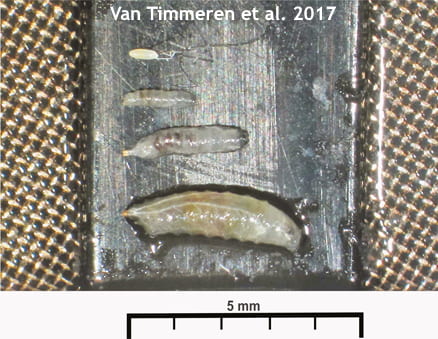Kelly Hamby, Associate Professor and Extension Specialist, Department of Entomology, University of Maryland; kahamby@umd.edu
Spotted-wing drosophila (SWD) is a small fly that lays its eggs into ripening and ripe soft-skinned fruit. Although they prefer fully colored ripe fruit, they are capable of infesting fruit that is just starting to turn color. Populations in non-crop habitats (wild fruits, compost, manure, nectar, fungi) can move into fruit crops, causing near continual pressure during the season in addition to pressure building on farm, especially when multiple susceptible fruit crops are grown. Caneberries (raspberries and blackberries) experience heavy pressure because they are preferred hosts and fruit during the mid-summer when SWD populations rapidly grow. Cold winters reduce overwintering populations, helping earlier season fruit such as strawberries, cherries, and earlier blueberry varieties escape damage. However, when we have warm winters with fewer days below freezing and warmer low temperatures, such as 2020 and 2021 (Table 1), populations build faster and more damage will occur, especially in cherries and blueberries.
Table 1. Calendar year minimum temperatures and days <32˚F in Damascus, MD.
| Calendar Year | Minimum Temperature ˚F |
Total Days <32 ˚F |
| 2018 | -1 | 100 |
| 2019 | -1 | 96 |
| 2020 | 15 | 63 |
| 2021 | 16 | 61 |
Monitoring
Monitoring can be used to determine if SWD is active on farm, and management decisions that combine SWD activity and fruit susceptibility (the riper the more susceptible) can help avoid unnecessary applications. There is no treatment threshold for SWD and acceptable damage varies by market and operation.
To determine when adults are active in cherries and blueberries, commercial adult traps and lures can be purchased and/or home-made traps and baits can be used. Traps have to be checked weekly and will capture non-target insects that have to be sorted through to find the adult flies. (see Michigan State’s fact sheet: https://www.canr.msu.edu/ipm/uploads/files/MI%20SWD%20Guide%20Cherry%20June_2020.pdf.
Checking fruit for SWD damage, eggs, and larvae can be used to determine SWD pressure and the effectiveness of management programs. Visual inspection of fruit looking for soft and leaky fruit can work to find infestation, and sampling fruit from the interior part of the plant where the habitat is more favorable and insecticide deposition is often poorer can help with early detection.
To monitor fruit infestation use salt or sugar water solutions to float eggs and larvae out of fruit. If you want to know if your management program is working, collect market ripe fruit. If you want to evaluate SWD pressure, collect interior soft and overripe fruit. Lightly crush fruit in a plastic bag or container. Add salt (1 cup salt to 1 gallon water) or sugar (1/4 cup granulated white sugar to 4 ¼ cup water) water and let the fruit soak below the surface for 15 – 60 minutes (the longer the more likely the larvae will leave the fruit). Pour the fruit and water solution through a coarse filter (to remove the fruit) stacked over a reusable basket style coffee filter. Rinse the soaking bag/container and pour the rinse liquid through the coffee filter too. The coffee filter will collect the eggs and larvae as well as smaller plant parts and fruit flesh if the fruit were crushed a bit too much. Carefully inspect the filter for SWD eggs and larvae with a magnifier (Figure 1).

Figure 1. SWD egg and larvae.
Management
Due to their broad host range and quick reproduction, SWD are difficult to manage. In most cases, especially in preferred hosts such as caneberries and later season varieties, a 7-day spray interval is required to maintain near 0 infestation levels, with tighter intervals when rain events occur. Accurate calibration of sprayers, appropriate spray volumes and tractor speeds, and other best practices to ensure good spray coverage are important. There are multiple effective insecticide modes of action for SWD, with group 1A carbamates (e.g., Lannate®) and group 1B organophosphates (e.g., diazinon, malathion), group 3A pyrethroids (e.g., Mustang-Maxx®, Danitol®), group 5 spinosyns (e.g., Delegate®, Entrust®), group 28 diamides (e.g., Exirel®, Verdepryn®) and the premix Cormoran® (group 4A neonicotinoid + group 15 benzoylurea) all ranking good to excellent. For organic production, there are a few OMRI approved materials, with Entrust® being the most effective option. Rotating modes of action (at a minimum alternate) helps avoid insecticide resistance. The label is the law, make sure the product is registered in your state and crop(s) and follow all restrictions.
Removing and destroying cull fruit and shortening harvest intervals to every 2-days can help reduce on-farm population. For some operations, mesh netting (1.0 x 0.6 mm or smaller) has proven very effective for delaying or reducing SWD, though sprays may be needed later in the season if populations build under the netting and supplemental pollination should be considered for some crops. Netting must be installed before SWD are active and cannot have any holes or be left open (e.g., worker or picker entry), so structures with entryways work best. Fruit yields and quality tend to be better when using netting which also protects from bird and other damage. Cooling fruit (32-36˚F) and holding it cold throughout the supply chain increases shelf life and reduces the likelihood that infestation will result in damaged or unmarketable fruit.
